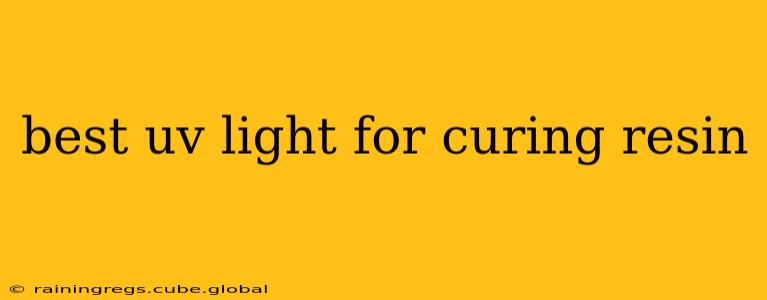Choosing the right UV light for curing resin can significantly impact the quality of your final product. Whether you're a seasoned resin artist or just starting, understanding the nuances of UV curing and selecting the appropriate light source is crucial. This guide will help you navigate the options and find the best UV light for your needs.
What Makes a UV Light Ideal for Resin Curing?
Several factors determine a UV light's suitability for resin curing. These include:
-
Wavelength: UV light is measured in nanometers (nm). Most resins cure best under UV light with a wavelength between 365nm and 405nm. Lights outside this range might cure slower or not at all. Pay close attention to the specified wavelength of any UV light you are considering.
-
Power (Wattage): Higher wattage generally translates to faster curing times. However, excessively high wattage can generate excessive heat, potentially damaging your resin or causing it to become brittle. A balance is key.
-
Intensity (mW/cm²): This measures the power density of the UV light. A higher intensity means faster curing, but again, moderation is important to avoid overheating. Look for lights that allow for intensity adjustment.
-
Exposure Time: Even with a powerful UV light, sufficient exposure time is crucial for complete curing. Undercuring can lead to sticky or weak finished products. Always follow the manufacturer's recommended curing times for your specific resin.
-
Portability and Size: Consider the size and portability of the light depending on your workspace and project size. Smaller lights are great for intricate details, while larger lights are suitable for larger projects.
What are the Different Types of UV Lights for Resin Curing?
Several types of UV lights cater to different needs and budgets:
-
UV LED Lights: These are generally preferred for their energy efficiency, long lifespan, and relatively low heat generation. They come in various sizes and wattages, offering versatility.
-
UV Fluorescent Lights (UV Lamps): These are more affordable but less energy-efficient and have a shorter lifespan than LEDs. They also generate more heat.
-
UV Nail Lamps: While designed for nail curing, some UV nail lamps can effectively cure resin, especially smaller projects. However, their wattage may be lower, resulting in longer curing times.
How Much Power (Wattage) Do I Need?
The wattage needed depends on your project's size and the type of resin. A higher wattage will cure faster but may generate more heat. Start with a moderate wattage and adjust based on your observations. Experimentation is key to finding the optimal balance between speed and heat control.
What is the Best Wavelength for Curing Resin?
The ideal wavelength for curing resin is generally between 365nm and 405nm. However, some resins may perform better with a specific wavelength within this range. Consult your resin manufacturer's instructions for the recommended wavelength.
How Long Does it Take to Cure Resin with a UV Light?
Curing time varies depending on the resin type, UV light intensity, and wattage. Always refer to your resin's instructions for specific curing times. However, expect curing times to range from a few seconds to several minutes.
Choosing the Right UV Light: Factors to Consider
Before purchasing, carefully consider these factors:
-
Your budget: UV lights range from affordable nail lamps to more expensive professional-grade units.
-
Project size and complexity: Larger projects require more powerful lights.
-
Resin type: Check the manufacturer's recommendations for the best UV wavelength and curing time.
-
Portability: Do you need a portable light for on-the-go projects?
-
Safety features: Look for lights with safety features like automatic shut-off to prevent overheating.
By carefully considering these factors, you can select the best UV light to achieve perfect resin curing every time, enhancing the quality and durability of your creations. Remember to always prioritize safety and follow the manufacturer's instructions for both the UV light and your resin.
